Posts: 130
Threads: 17
Joined: Dec 2016
Location: Melbourne, Australia
(02-22-2018, 11:36 AM)Vinny Wrote: This page has a lot of useful info on surface grinders, and grinders/grinding in general. Unfortunately all it says about the dresser is "slight angle". As I recall, when I made mine, somewhere I found the number 5 degrees so that's what I went with.
http://www.americanmachinetools.com/how_...rinder.htm
Great info there Vinny.
Figure 5.14 has a good diagram and states "
Slant the diamond 3° to 15° in the direction of rotation and 30° to the plane of the wheel as shown in Figure 5-14 to prevent chatter and gouging."
There's other good dressing info in that section too.
Steve
Posts: 130
Threads: 17
Joined: Dec 2016
Location: Melbourne, Australia
I've decided I'm going to convert the grinder back to manual rather than work on getting the pneumatics going right now.
Multiple reasons but mainly I think its going to be easier to learn using a fully manual machine.
Currently my cross feed shaft is missing the handwheel, but it has a chain sprocket on the drive end. The decal on the wheel guard mentions the need to adjust the cable after prolonged use, so I figure it was originally cable driven. Seems reasonable to return it back to that.
So I'll need a handwheel, cable drum, and some cable/fittings.
Doing some rough on-screen measuring from a photo I found of my model, it looks like the handwheel should be about 9" diameter. Does that seem about right?
Trying to work out the traverse rate, I found an online spec with a travel of 2.7"/rev for a similar 6x18 grinder. I've also found photos of a Norton machine that appears to have a drum around 2" diameter (so ~6"/rev assuming direct drive)
Anyone with a grinder care to give me a sanity check on the travel rate?
Steve
Posts: 968
Threads: 67
Joined: Apr 2015
Location: Australia
03-01-2018, 07:57 AM
(This post was last modified: 03-01-2018, 08:03 AM by Pete O.
Edit Reason: addendum
)
I took a couple of measurements on my grinder this afternoon Steve, the X-axis handwheel is 200mm O.D. and the X-axis travels 120mm per revolution. Also I checked the angle of the diamond in the dresser, it is 7.5 degrees from vertical. The picture below shows the dressing jig, I did find the hole in the base useful, it enabled me to bolt it to an angle block to dress the side of the wheel using Z-axis travel the couple of times I have wanted to side-wheel, the first of which was to grind the back fence of the chuck parallel to X.
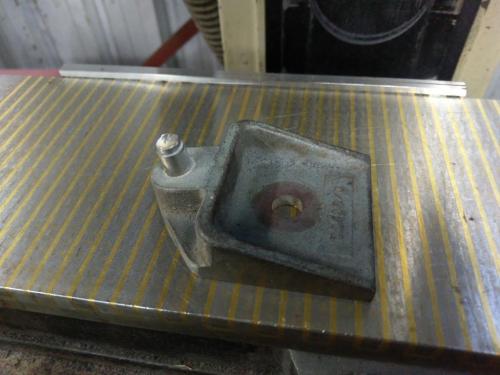
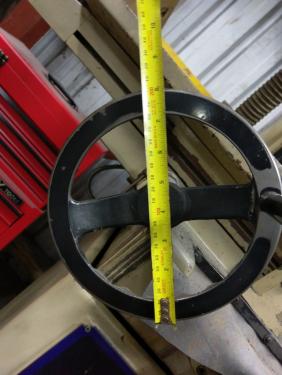
Edit; just re-read your last post and thinking about the drive, it could be that there was a chain drive with the free ends of the chain connected by a cable, or connected to the underside of the table by a cable. A chain and sprocket would provide relatively positive position locking of the X-axis when this is required (such as dressing), mine is locked at the handwheel axle rather than the table itself.
Lathe (n); a machine tool used in the production of milling machine components.
Milling Machine (n); a machine tool used in the production of lathe components.
Posts: 130
Threads: 17
Joined: Dec 2016
Location: Melbourne, Australia
The following 1 user Likes SteveG's post:
f350ca (03-01-2018)
Awesome - thanks for the info Pete.
I managed to find a suitable size handwheel in the scrap junk at work. Its much more solid than required so I think will go on a diet in the lathe - just to thin it a bit in general to reduce the mass without spending too much time.
Bore just needs to be opened up about 3mm to suit the grinder shaft, and think I'll modify the current solid crank handle so that it runs in a bush while I'm at it
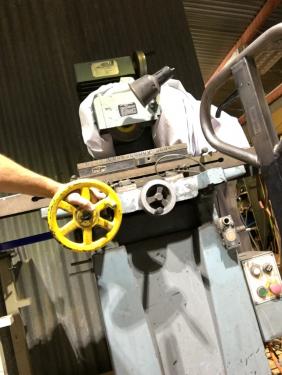
Steve
Posts: 130
Threads: 17
Joined: Dec 2016
Location: Melbourne, Australia
The following 1 user Likes SteveG's post:
f350ca (03-05-2018)
Last night I removed the table to take a better look. It was definitely chain drive before the pneumatic conversion:
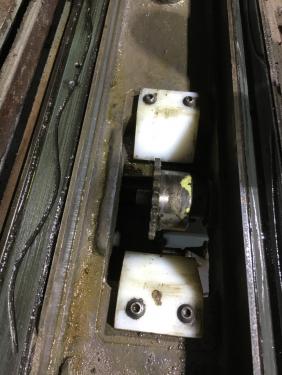
Removed the handwheel shaft and its outer housing. Bearings are only single metal shield type and rough.
Also found that although there's plenty of oil output at the oiler, nothing is coming out the delivery holes in the ways. Guess they are full of old gunge that was once oil, so another one for the task list.
Picked up a couple of new bearings today, and a box of chain to match the sprocket. Hoping I might get lucky and find that the pins in the chain are the same size as the adjuster block on the table:
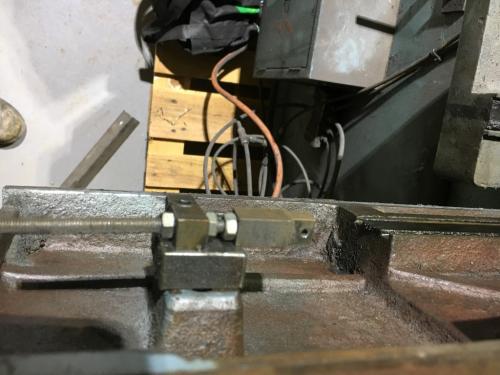
Steve
Posts: 130
Threads: 17
Joined: Dec 2016
Location: Melbourne, Australia
The following 1 user Likes SteveG's post:
f350ca (03-05-2018)
New chain is a perfect fit:
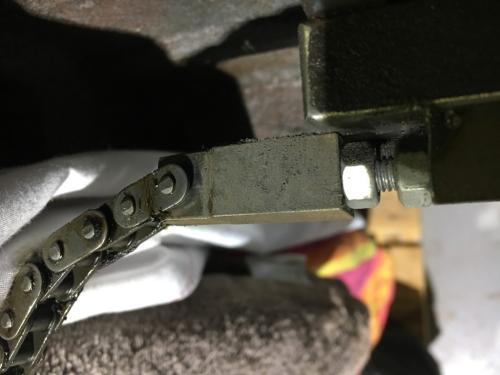
Steve
Posts: 968
Threads: 67
Joined: Apr 2015
Location: Australia
That makes the decal that you mentioned earlier, alluding to adjustment of a cable, a bit of a mystery, doesn't it?
Lathe (n); a machine tool used in the production of milling machine components.
Milling Machine (n); a machine tool used in the production of lathe components.
Posts: 130
Threads: 17
Joined: Dec 2016
Location: Melbourne, Australia
The following 1 user Likes SteveG's post:
f350ca (03-05-2018)
I thought so initially, but now convinced the chain drive is definitely a conversion - the boss for the sprocket is welded onto the sprocket then machined off (leaving a small bit of weld unmachined), and the adjuster also looks like its been shop made rather than a factory made part.
So I'm guessing originally cable, converted to chain, then pneumatic, and now being converted back to chain :)
Steve




